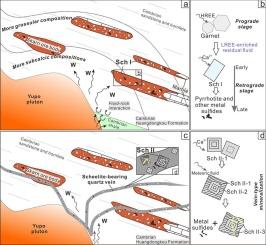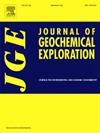Fluctuations of trace elements and Sr isotopes of the multi-stage scheelite in the reduced polymetallic Yupo tungsten skarn deposit, South China: Implications for ore-forming process
Abstract
The Yupo scheelite (Sch)-bearing deposit is hosted in the external contact zones between the Yupo granodiorite and Cambrian Huangdongkou Formation of South China. The stratiform ore bodies contain hedenbergitic pyroxene (Hd23–69) and andradite-poor garnet (Ad0–22) assemblages, indicating that Yupo is a typical reduced W skarn deposit. The garnet compositions are zoned in a deposit scale inwardly from the periphery of the grossular-rich skarn reaction front to more subcalcic compositions. Scheelite occurs mainly as disseminated grains in the skarn coeval with retrograde alteration (Sch I) and in quartz veins crosscutting skarns (Sch II-1, -2, and -3). Sch II-1 occurs as cores rimmed by Sch II-2, and Sch II-3 as veinlet cutting both of them. The Sch I and Sch II-3 show weak Eu anomalies different from the pronounced positive Eu anomalies of Sch II-1 and -2. All the scheelite contains low Mo contents (<0.1 wt%), together with the subordinate precipitation of molybdenite, indicating a reduced ore-forming fluid system. The Mo content and Eu anomaly jointly reveal that the reducing condition enhanced from Sch I to Sch II-1 and alleviated from Sch II-1 to Sch II-3. The four scheelite generations show gradually increased initial 87Sr/86Sr ratios from 0.7144 to 0.7242, which are higher than that of the magmatic apatite (0.7082–0.7127) and the carbonate rocks (0.7104–0.7109). The Cambrian carbonaceous shale is a high (87Sr/86Sr)i endmember that interacted with the initial ore-forming fluid; continuing interaction was deemed to enhance the reduction of the ore-forming fluid from Sch I to Sch II-1. Weakening of the intensity of fluid-rock interaction with carbonate rocks during vein-type mineralization caused the (87Sr/86Sr)i values of the scheelite to increase gradually. The input of meteoric water decreased the fluid reduction capability during the formation of Sch II-1 to Sch II-3. Fluid-rock interaction dominated the scheelite mineralization of the reduced W skarn deposit.


 求助内容:
求助内容: 应助结果提醒方式:
应助结果提醒方式:


